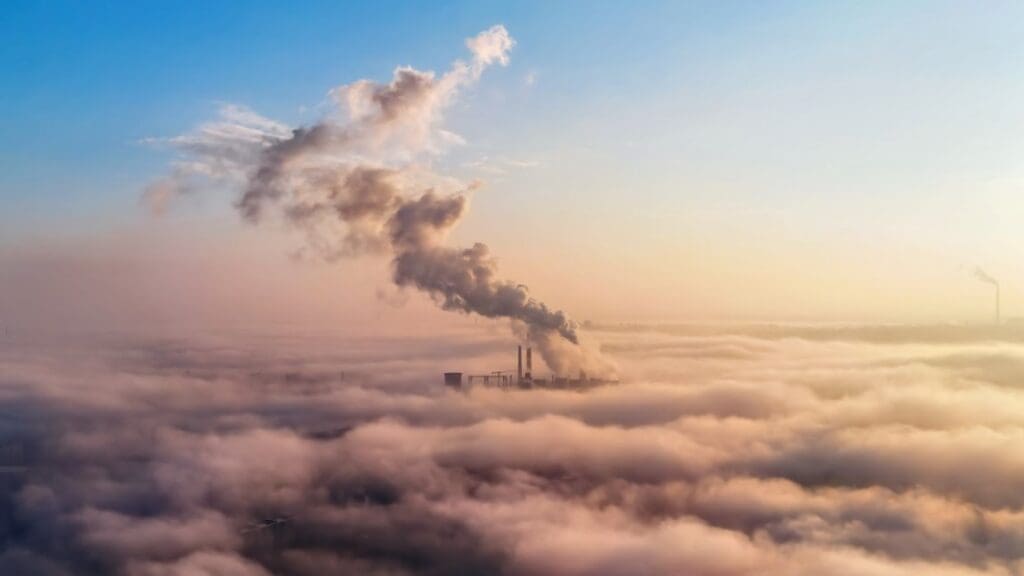Explore the latest insights from top science journals in the Muser Press daily roundup (August 1, 2025), featuring impactful research on climate change challenges.
In brief:
Rainy tropics could face unprecedented droughts as an Atlantic current slows
In a new CU Boulder-led study published in Nature, scientists revealed that even a modest slowdown of a major Atlantic Ocean current could dry out rainforests, threaten vulnerable ecosystems and upend livelihoods across the tropics.
“That’s a stunning risk we now understand much better,” said lead author Pedro DiNezio, associate professor in CU Boulder’s Department of Atmospheric and Oceanic Sciences, adding that parts of the Amazon rainforest could see up to a 40% reduction in annual precipitation.
The ocean conveyor belt
The Atlantic Meridional Overturning Circulation (AMOC) is a massive system of ocean currents that moves water through the Atlantic Ocean, transporting warm, salty water from the tropics to the North Atlantic. The AMOC plays an important role in regulating the climate by redistributing heat from the southern to the northern hemisphere. It also makes sure the tropical rain belt, a narrow band of heavy precipitation near the equator, stays north of it.
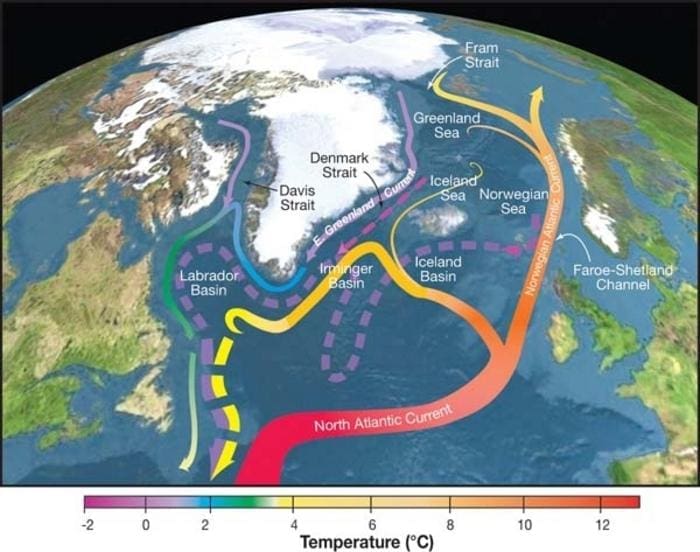
As the climate warms, melting polar ice and increasing rainfall will dilute the ocean’s surface waters, making them less dense and potentially slowing down the circulation. The impact of a weakened AMOC on the tropics remains uncertain, because scientists have only been monitoring the system directly for two decades.
As a technician at a National Oceanic and Atmospheric Administration (NOAA) lab in Miami in 2005, DiNezio helped calibrate some of the earliest measurements of AMOC. At the time, he had no idea that he’d be studying that very same system two decades later.
“A few years ago, this monitoring system recorded signs of a decline in the AMOC, but it later rebounded. So we weren’t sure if it was just a fluke. The problem is, we haven’t been measuring the ocean long enough to detect meaningful long-term change,” DiNezio said.
While scientists are uncertain whether the AMOC has already begun to decline, climate models predict the system will eventually weaken because of climate change.
Predicting the future
DiNezio and his team set out to explore how a future slowing of these critical ocean currents could impact global precipitation patterns.
“Changes in rainfall are very difficult to predict, because so many factors are involved in making rain, like moisture, temperature, wind and clouds. Many models struggle to predict how the pattern will change in a warming world,” DiNezio said.
The team turned to climate records from about 17,000 years ago, when the AMOC last slowed down significantly due to natural causes. Evidence of precipitation preserved in cave formations, as well as lake and ocean sediments revealed how rainfall patterns responded to the slowdown during that period.
Drawing on that data, DiNezio’s team identified the computer models that best captured those ancient rainfall shifts and used them to predict how the patterns could change in the future.
Their best models predict that as the AMOC weakens and cools the northern Atlantic, this temperature drop would spread toward the tropical Atlantic and into the Caribbean. This change, on top of rising global temperatures, will lead to significant reductions in precipitation over Central America, the Amazon, and West Africa.
“This is bad news, because we have these very important ecosystems in the Amazon,” said DiNezio. The Amazon rainforest contains almost two years of global carbon emissions, making it a major carbon sink on Earth. “Drought in this region could release vast amounts of carbon back into the atmosphere, forming a vicious loop that could make climate change worse.”
While DiNezio said the AMOC is unlikely to stop completely, even a small reduction in its strength could lead to changes across the entire tropical region, increasing the risk of reaching a tipping point. But how fast and how much it slows depends on the degree of future climate change.
“We still have time, but we need to rapidly decarbonize the economy and make green technologies widely available to everyone in the world. The best way to get out of a hole is to stop digging,” DiNezio said.
Journal Reference:
DiNezio, P.N., Shanahan, T.M., Sun, T. et al., ‘Tropical response to ocean circulation slowdown raises future drought risk’, Nature (2025). DOI: 10.1038/s41586-025-09319-x
Article Source:
Press Release/Material by Yvaine Ye | University of Colorado at Boulder (CU Boulder)
How are coastal New Jersey communities communicating hazards of climate change?
Recent climate-related crises – from severe storms and flooding to extreme heat – have raised new questions about how local governments communicate the risk of these crises and what they are doing to keep their citizens safe.
To better understand what this communication looks like at local level, and the factors that may be shaping it, researchers from Drexel University analyzed climate resilience planning information available on the public-facing websites of 24 coastal communities in New Jersey that are contending with the effects of sea level rise. Their report, recently published in the Journal of Extreme Events, found wide variation in the number and extent of mitigation actions taken and how the websites describe causes of coastal hazards – for example, only half of the communities are acknowledging sea level rise as a contributing factor to these hazards.
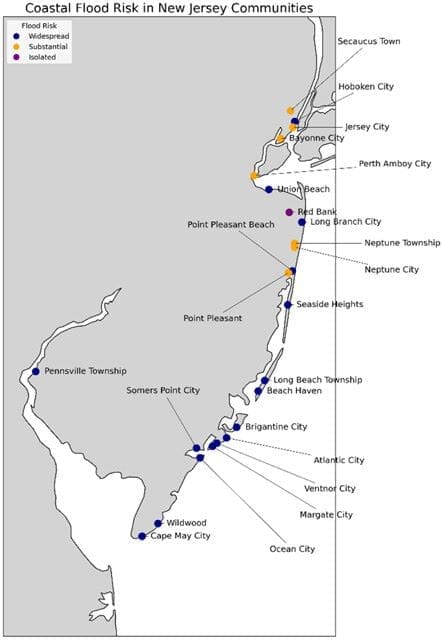
“Each municipality handles this communication a little differently – perhaps due to their relative risk, experience with flooding, or possibly because of their perception of what the public will accept as a feasible strategy. So, a study like this is important for comparing the information being conveyed and understanding localized variations,” said Patrick Gurian, PhD, a professor in Drexel’s College of Engineering, who led the research.
According to real estate data, New Jersey has more new homes being built in flood risk zones than any other state. The study looked at many of these communities, from Secaucus, Hoboken and Jersey City in the north, through Point Pleasant and Seaside Heights and down to Wildwood and Cape May on the southern tip – ranging in relative risk for flooding: “widespread,” “substantial” or “isolated,” which were categorized based on the percentage of their land area 10 feet or less above sea level.
The study compared the communities’ relative activity, as reported on their websites, through the lens of a climate adaptation index, which was defined as the sum of actions taken from a set of measures often considered by local governments in climate vulnerable areas – ranging from stormwater management and zoning policies to incentives to renovate or relocate.
The analysis revealed a wide range in the number of projects being undertaken, or publicized, with roughly half of the communities showing a high degree of activity and the other half showing much lower overall activity. The projects most frequently mentioned as being planned, in progress or completed, were projects addressing public infrastructure, with 62% of communities undertaking stormwater management projects and 50% undertaking road improvements.
By contrast, none mentioned more permanent, but costly and controversial measures, such as managed retreat or buyout programs to help citizens relocate from vulnerable areas.
“Managed retreat planning is seemingly the least favored strategy among New Jersey coastal municipalities, whereas stormwater management and road improvements seem to be the most favored adaptation projects, likely due to their acceptance by the public and technical feasibility,” the researchers wrote.
Gurian, who has participated in related efforts to assess and bolster climate resilience plans in the Greater Philadelphia area, has a deep understanding of the underlying influences that can shape these strategies, including political undercurrents. But Gurian noted that, in the case of these two dozen communities in New Jersey, political leaning did not appear to be associated with whether they communicate about preparedness efforts.
The researchers overlaid voting behavior in the 2020 presidential election with reported climate risk preparedness activities. Of the 24 communities studied, 13 leaned Democrat and 11 Republican, per the 2020 results. But across the board, the strongest predictor of preparedness activities was being in an area classified as having “widespread risk” for coastal flooding – the most severe coastal flooding risk category.
“Based on the results of this study, there are significant associations between the coastal flood risk for a community and the risk mitigation activities reported on governmental websites,” the researchers reported. “Population and favored political party (as measured by the 2020 presidential vote) were not found to have a significant influence on overall coastal preparedness.”
But a subtle indication of the political sensitivity around the framing of the problem may be visible in the websites’ language, or lack thereof, about climate change and sea level rise. Less than half (46%) provided information about the contribution of climate change and sea level rise to coastal hazard risk and even fewer (17%) acknowledged climate change and sea level rise and attributed them to human activity. The researchers suggested that avoiding this language may be a tactic to maintain support for the mitigation activities.
“Acknowledging climate change without attributing it to human activity may provide a window for governments to advance adaptation efforts while avoiding the potentially more controversial topics of causal attribution and emissions mitigation,” the researchers wrote.
While this study is limited to a small set of coastal communities in New Jersey, the team notes that its implications likely map onto similar municipalities in climate vulnerable areas across the country (n.e. U.S.A.). The researchers recommend expanding both the geographic footprint in similar studies and efforts to capture local information sharing beyond websites, as not all governments may view or operate their websites as a primary means of communicating with citizens.
Gurian suggested this line of inquiry will become increasingly important as demand for coastal property and coastal flood risk are both increasing.
“The way local leaders and governments communicate about climate risk is vitally important because it not only shares urgent information that can help to keep citizens safe in the immediate future, but it also conveys a perspective of the problem that sets a framework for how citizens should perceive their own relative risk,” Gurian said.
“Despite our divisive national political landscape, local governments can still communicate with their citizens about climate-related hazards. If local governments can preserve and leverage this relationship, while carefully and accurately communicating the risk climate change poses to their communities, they may yet be able to keep their citizens safe.”
Journal Reference:
Kristopher Cadieux, Alexandra Eichhorn, Catherine Quinn, Kerrianne Parrish, Asia Mae Somboonlakana, William Solecki, and Patrick L. Gurian, ‘Coastal Adaptation Information on Local Government Websites in New Jersey’, Journal of Extreme Events online (2025). DOI: 10.1142/S2345737625500034
Article Source:
Press Release/Material by Drexel University
From Italy, two new solutions for coral protection: a conductive biopaste and a natural healing patch
A research group in Italy has developed two new coral protection technologies for healing and restoring coral reefs: a biopaste and a natural patch, both successfully tested on real corals. The two solutions resulted from the collaboration among researchers at the University of Milano-Bicocca in Milan, the Istituto Italiano di Tecnologia (IIT-Italian Institute of Technology) in Genoa, and the Acquario di Genova (Aquarium of Genoa).

Threatened by climate change and increasingly vulnerable, coral reefs are crucial ecosystems for marine biodiversity and the survival of many coastal communities. In addition to being a fundamental resource for fishing and tourism, reefs play a key role in global ecological balance. To counteract their progressive degradation, scientific research is focusing on innovative solutions that combine eco-compatibility, effectiveness, and rapid intervention.
The first solution realized by the research group is a green, fully biodegradable biopaste capable of anchoring corals while simultaneously accelerating their growth through electrochemical mineralization technology. Described in a study published in the journal Advanced Materials1, the new material, named “Active Biopaste”, is a paste made from modified soybean oil and graphene.

The two substances, once mixed, harden in a controllable way and become a solid, conductive substrate to anchor coral fragments and support Mineral Accretion Technology (MAT), a technique that stimulates their growth. The paste exhibits stable properties for over 40 days in seawater, and MAT tests show significant enhancement of coral growth rates within two weeks, doubling those of the control group.
“What makes our solution unique is the integration of two essential functions into a single innovative material,” explains Gabriele Corigliano, first author of the study and a PhD student in Marine Sciences at Bicocca and in the Smart Materials unit at IIT, coordinated by Athanassia Athanassiou.
“On one hand, this paste simplifies the attachment of corals, making it safer and more reliable both in underwater nurseries and on the reef. On the other hand, thanks to its conductive properties, it promotes coral growth through MAT, a technique that uses low-intensity electric currents to deposit calcium carbonate on metal structures – this is the material corals use to build their skeletons. Unlike traditional MAT, no permanent structures are needed, eliminating the risk of corrosion and long-term pollution. Overall, our approach actively promotes coral growth and is safe for marine life.”
“We aim to push current knowledge in materials science as far as possible to produce technologies that are effective and multifunctional underwater, while also respecting the environment and aligning with the United Nations’ sustainability goals,” adds Marco Contardi, researcher at the MaRHE Center at Bicocca and member of the Smart Materials unit at IIT. “This approach allows us to design materials intended for the sea and for marine use, always considering their effects during and after application, such as biodegradation.”
“This study highlights the profound transformation underway in marine sciences,” notes Simone Montano, associate professor in the Department of Environmental and Earth Sciences and deputy director of the MaRHE Center at the University of Milano-Bicocca. “The synergy between the three research groups – the MaRHE Center at the University of Milano-Bicocca, the IIT Smart Materials team, and the Aquarium of Genoa – demonstrates how the development of innovative and sustainable technologies can buy us the time needed for mitigation policies to take effect. Only through joint efforts like this can we give nature the chance to return to its original balance.”
This same collaboration also led to a second major contribution to reef conservation, published in the journal One Earth2. First author of this study is Vincenzo Scribano, a PhD student at the University of Milano-Bicocca and member of the Smart Materials unit at IIT, who developed an eco-compatible system for the targeted delivery of antibiotics to diseased corals – a sort of patch combining a hydrophilic film loaded with antibiotics (made from chitosan, a polymer derived from shellfish) with a natural hydrophobic sealant based on beeswax and plant oils from sunflower and flax.
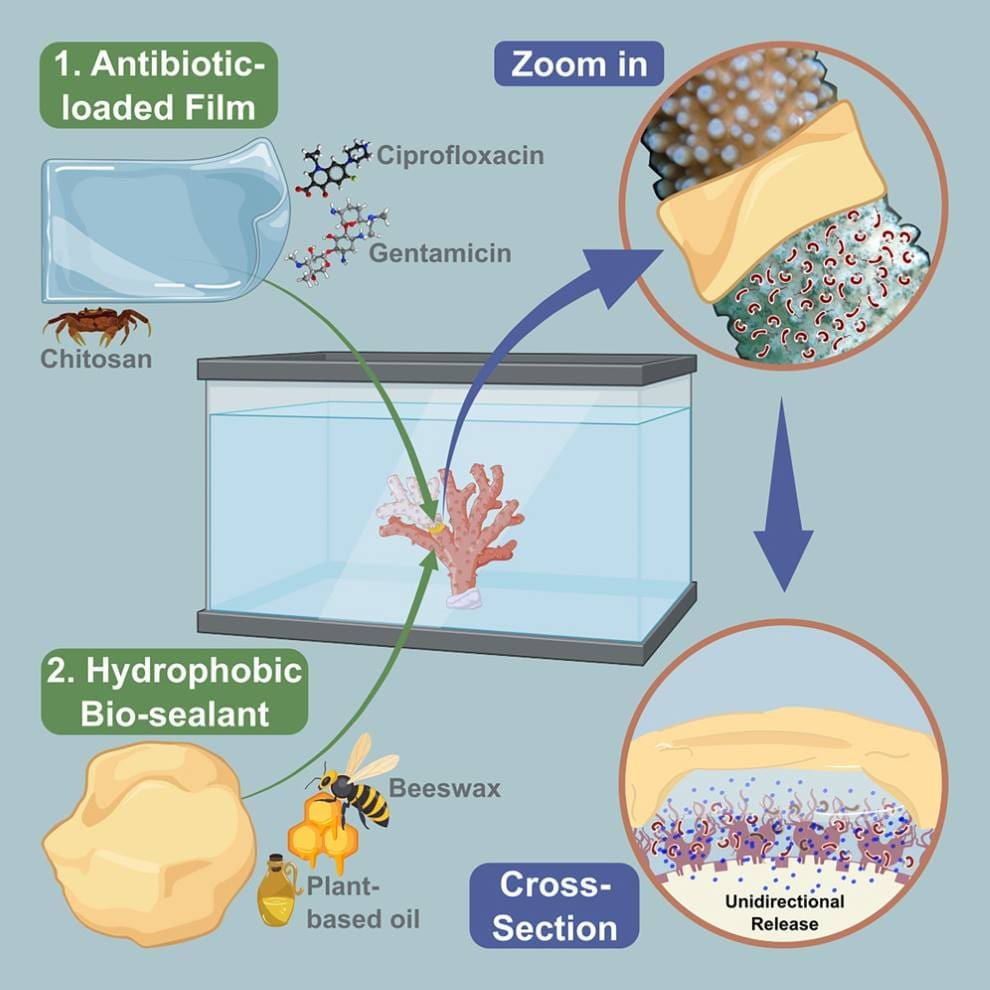
All materials are natural and, once degraded, do not harm the marine ecosystem. In aquarium tests, the treatment halted the disease’s progression in over 90% of the cases.
“This technology allows us to treat corals affected by aggressive diseases that damage their tissue and spread rapidly across coral reefs,” explains Scribano. “Thanks to the dual-layer system, the antibiotics are released exclusively on the infected coral area, and the delivery is sealed off by the paste, preventing the spread of antibiotics into the marine environment. The technology has proven particularly effective against a disease in the tissue necrosis family, which is widespread in aquaculture.”
“With these studies, we’ve demonstrated the potential of a responsible approach to materials design,” says Athanassia Athanassiou, Principal Investigator and Head of the Smart Materials unit at IIT. “The goal is to develop sustainable solutions that support living organisms and protect biodiversity. We conduct in-depth research on sustainable materials, evaluating their effectiveness and end-of-life impact, always with a design approach that considers environmental consequences. Today, every design decision we make is guided by a responsible and sustainable scientific vision.”
These results are part of a long-term research initiative by the joint team from the University of Milano-Bicocca, IIT, and the Aquarium of Genoa, which has become an international reference point in the development of coral conservation technologies. This interdisciplinary approach has already led to previous innovations, such as the use of curcumin, a natural antioxidant extracted from turmeric, to reduce coral bleaching.
Materials and innovations are tested at the MaRHE Center facility within the Aquarium of Genoa, which, thanks to its solid expertise in the field, controlled environment, and attention to animal welfare, is an ideal setting for developing solutions aimed at marine conservation. This integrated vision sees the sea not only as an ecosystem to protect but also as a laboratory for imagining a more sustainable future in harmony with the environment.
Journal Reference:
(1) G. Corigliano, V. Isa, V. F. Annese, C. Rinaldi, M. Summa, R. Bertorelli, P. Galli, S. Lavorano, M. Caironi, M. Contardi, P. Cataldi, S. Montano, A. Athanassiou, ‘Active Biopaste for Coral Reef Restoration’, Advanced Materials online, 2502078 (2025). DOI: 10.1002/adma.202502078
(2) Vincenzo Scribano, Marco Contardi, Camilla Rinaldi, Valerio Isa, Fabrizio Fiorentini, Luca Ceseracciu, Isabella Gandolfi, Isabella Ghizzi, Silvia Lavorano, Paolo Galli, Simone Montano, Athanassia Athanassiou, ‘Eco-friendly active film and sealant for underwater drug delivery to diseased corals’, One Earth 8, 7: 101356 (2025). DOI: 10.1016/j.oneear.2025.101356. Also available on ScienceDirect.
Article Source:
Press Release/Material by Istituto Italiano di Tecnologia (IIT)
Ocean oxygen decline threatens deep-sea fish populations and ocean health, new study warns
The ongoing decline in ocean oxygen levels is intensifying due to climate change, significantly impacting marine ecosystems, including mesopelagic fish populations. This could disrupt marine food webs, fisheries, ocean health, and the ocean’s capacity to store carbon.
These are the findings of an international study led by the Institute of Environmental Science and Technology at the Universitat Autònoma de Barcelona (ICTA-UAB), Spain, which investigated how marine ecosystems responded to past episodes of ocean deoxygenation. To do so, researchers studied fossil remains of lanternfish – one of the most abundant and important fish families of the deep ocean – preserved in seabed sediments of the Eastern Mediterranean, dating back more than 10,000 years.
The findings have been published in the journal Communications Earth & Environment.
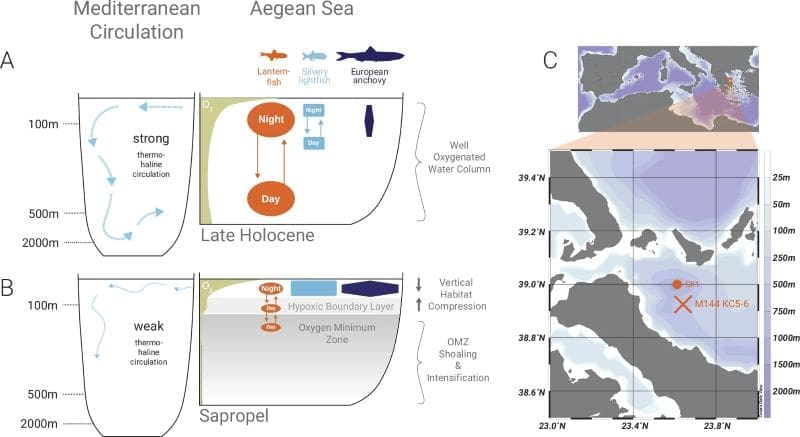
Lanternfish are very small, deep-sea fish of the family Myctophidae, named for their ability to produce light through bioluminescent organs. Regardless of their small size, with an estimated biomass of 600 million tons, lanternfish are extremely abundant in the global ocean, possibly making them the most abundant vertebrates on Earth by weight. During the day, lanternfish live in the dark mesopelagic zone (200–1000 meters deep) to hide from predators, while during the night they swim to the ocean surface to feed on zooplankton.
Owing to both their great biomass and diel vertical migration, lanternfish play a very important role in climate regulation, and the ocean food webs, connecting the surface with the deep ocean. Therefore, lanternfish are widely considered a good indicator group for mesopelagic ecosystem health.
However, the fossil record shows that lanternfish were largely absent during periods of extreme oxygen depletion. They only reappeared – and in large numbers – once oxygen levels increased again, around 6,000 years ago.
The team, including researchers from Scripps Institution of Oceanography (USA), Woods Hole Oceanographic Institution (USA), Biodiversity Research Center at Academia Sinica (Taipei, Taiwan), McGill University (Canada), Freie Universität Berlin (Germany), and Heidelberg University (Germany), used fossil otoliths to reconstruct past fish populations. The Eastern Mediterranean Sea, which has alternated over the past ten thousand years between well-oxygenated and highly anoxic conditions, provided a unique natural archive for studying the biological impacts of deoxygenation events.
“The case of lanternfish clearly illustrates what may happen on a larger scale if ocean deoxygenation continues. If a group with such massive biomass disappears, other marine species are also likely to be at risk,” warns Sven Pallacks, main author of the study.
The twilight zone – mesopelagic zone, located between 200 and 1,000 meters deep – plays a key role in Earth’s climate system, primarily through its influence on the global carbon cycle. The results suggest that mesopelagic ecosystems are particularly vulnerable to oxygen loss. Their collapse could destabilize ecological balances in the ocean, impair its role in global carbon cycling, and pose a threat to marine biodiversity and global food security.
Journal Reference:
Pallacks, S., Ziveri, P., Jannke, H.A. et al., ‘Ocean deoxygenation linked to ancient mesopelagic fish decline’, Communications Earth & Environment 6, 596 (2025). DOI: 10.1038/s43247-025-02568-8
Article Source:
Press Release/Material by Universitat Autonoma de Barcelona (UAB)
Featured image credit: Gerd Altmann | Pixabay




